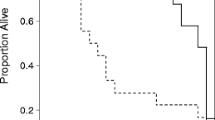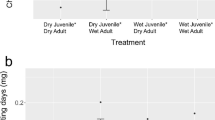Abstract
Using the spotted cucumber beetle, Diabrotica undecimpunctata howardi, as a model species, we begin an examination of the role of dietary cucurbitacins, the bitter tetracyclic triterpenes produced by cucurbits, in the reproductive behavior of luperine chrysomelids that seek these compounds for purposes other than host-plant recognition or nutrition. By manipulating the cucurbitacin content of adult diets, we determine: (1) how males and females partition cucurbitacins between reproductive organs and other tissues, (2) the extent to which males pass cucurbitacins to females during copulation, and (3) if females increase their cucurbitacin stores via multiple matings. After two days of exposure to dietary cucurbitacins, 8.3 times more cucurbitacins per gram dry weight were sequestered in male spermatophores than in the aggregate of remaining male tissues. These cucurbitacin-rich spermatophores were passed to females during mating, and 78.8% of the transferred cucurbitacin was deposited in eggs, 11.8% was irreversibly sequestered in other female tissues, and 9.4% was apparently excreted. Females copulated with 0–15 males prior to accepting a complete spermatophere, but did not accept measurable amounts of cucurbitacin from rejected males. Regardless of when it was received, females lost subsequent receptivity to additional males after accepting a complete spermatophore. The implications of these data are discussed in terms of sexual selection hypotheses and mating behavior in cucumber beetles.
Similar content being viewed by others
REFERENCES
Andersen, J. F., Plattner, R. D., and Weisleder, D. 1988. Metabolic transformations of cucurbitacins by Diabrotica virgifera virgifera LeConte and D. undecimpunctata howardi Barber. Insect Biochem. 18:1-78.
Barbercheck, M. E., WANG, J., and HIRSH, I. S. 1995. Host plant effects on entomopathogenic nematodes. J. Invert. Pathol. 66:169-177.
BopprÈ, M. 1978. Chemical communication, plant relationships, and mimicry in the evolution of danaid butterflies. Entomol. Exp. Appl. 24:64-77.
BopprÈ, M. 1984. Redefining “pharmacophagy.” J. Chem. Ecol. 10:1151-1154.
BopprÈ, M. 1986. Insects pharmacophagously utilizing defensive chemicals (pyrrolizidine alkaloids). Naturwissenchaften 73:17-26.
BopprÈ, M. 1990. Lepidoptera and pyrrolizidine alkaloids: Exemplification of complexity in chemical ecology. J. Chem. Ecol. 16:165-180.
Branson, T. F., and Krysan, J. L. 1981. Feeding and oviposition behavior and life cycle strategies of Diabrotica: An evolutionary view with implications for pest management. Environ. Entomol. 10:826-831.
Brust, G. E., and Barbercheck, M. E. 1992. Effect of dietary Cucurbitacin C on southern corn rootworm (Coleoptera: Chrysomelidae) egg survival. Environ. Entomol. 21:1466-1471.
Chambliss, O. L., and Jones, C. M. 1966. Cucurbitacins: Specific insect attractants in Cucurbitaceae. Science 153:1392-1393.
Chyb, S., Eichenseer, H., Hollister, B., Mullin, C. A., and Frazier, J. L. 1995. Identification of sensilla involved in taste mediation of adult western corn rootworm (Diabrotica virgifera virgifera LeConte). J. Chem. Ecol. 21:313-329.
Cordero, C. 1995. Ejaculate substances that affect female insect reproductive physiology and behavior: Honest or arbitrary traits? J. Theor. Biol. 174:453-461.
Deheer, C. J., and Tallamy, D. W. 1991. Cucumber beetle larval affinity to cucurbitacins. Environ. Entomol. 20:775-788.
Dodson, C. H. 1975. Coevolution of orchids and bees. pp. 91-99, in L. E. Gilbert and P. H. Raven (eds.). Coevolution of Animals and Plants. University of Texas Press, Austin.
Dussourd, D. E., Harvis, C. A., Meinwald, J., and Eisner, T. 1989. Paternal allocation of sequestered plant pyrrolizidine alkaloid to eggs in the danaine butterfly, Danaus gilippus. Experienta 45:896-898.
Eberhard, W. G. 1996. Female control: Sexual selection by cryptic female choice, Princeton University Press, Princeton.
Eberhard, W. G., and Cordero, C. 1995. Sexual selection by cryptic female choice on male seminal products-a new bridge between sexual selection and reproductive physiology. TREE 10:493-496.
Edgar, J. A. 1982. Pyrrolizidine alkaloids sequestered by Solomon Island Danaine butterflies. The feeding preferences of the Danainae and Ithomiinae. J. Zool. 196:385-399.
Eisner, T., Smedley, S. R., Young, D. K., Eisner, M., Roach, B., and Meinwald, J. 1996. Chemical basis of courtship in a beetle (Neopyrachroa flabellata): Cantharidin as “nuptial gift.” Proc. Natl. Acad. Sci. U.S.A. 93:6499-6503.
Ferguson, J. E., and Metcalf, R. L. 1985. Cucurbitacins: Plant-derived defense compounds for diabroticites (Coleoptera: Chrysomelidae). J. Chem. Ecol. 11:311-317.
Ferguson, J. E., Metcalf, R. L., and Fischer, D. C. 1985. Disposition and fate of cucurbitacin B in five species of diabroticites. J. Chem. Ecol. 11:1307-1321.
Gould, F., and Massey, A. 1984. Cucurbitacins and predation of the spotted cucumber beetle, Diabrotica undecimpunctata howardi. Entomol. Exp. Appl. 36:273-278.
Halaweish, F. T., and Tallamy, D. W. 1993. A new cucurbitacin profile for Cucurbita andreana: A candidate for cucurbitacin tissue culture. J. Chem. Ecol. 19:1135-1141.
Halaweish, F. T., Tallamy, D. W., and Santana, E. 1999. Cucurbitacins: A role in cucumber beetle sterol nutrition? J. Chem. Ecol. 25:2373-2383.
Howe, W. L., Sanborn, J. R., and Rhodes, A. M. 1976. Western corn rootworms and spotted cucumber beetle associations with Cucurbita and cucurbitacin. Environ. Entomol. 5:1043-1048.
Krasnoff, S. B., and Dussourd, D. E. 1989. Dihydropyrrolizidine attractants for arctiid moths that visit plants containing pyrrolizidine alkaloids. J. Chem. Ecol. 15:47-56.
Lamunyon, C. W., and Eisner, T. 1993. Postcopulatory sexual selection in an arctiid moth (Utetheisa ornatrix). Proc. Natl. Acad. Sci. U.S.A. 90:4689-4692.
Lamunyon, C. W., and Eisner, T. 1994. Spermatophore size as determinant of paternity in an arctiid moth (Utetheisa ornatrix). Proc. Natl. Acad. Sci. U.S.A. 91:7081-7084.
Lew, A. C., and Ball, H. J. 1980. Effect of copulation time on spermatozoan transfer of Diabrotica virgifera (Coleoptera: Chrysomelidae). Ann. Entomol. Soc. Am. 73:360-361.
Meinwald, J., Meinwald, V. C., and Mazzocchi, P. H. 1969. Sex pheromone of queen butterfly: Chemistry. Science 164:1174-1175.
Metcalf, R. L. 1994. Chemical ecology of diabroticites, pp. 153-169, in P. H. Jolivet, M. L. Cox, and E. Petitpierre (eds.). Novel Aspects of the Biology of Chrysomelidae. Kluwer Academic, Boston.
Metcalf, R. L., Metcalf, R. A., and Rhodes, A. M. 1980. Cucurbitacins as kairomones for diabroticite beetles. Proc. Natl. Acad. Sci. U.S.A. 17:3769-3772.
Nielsen, J. K., Larsen, M., and Sorenson, H. J. 1977. Cucurbitacins E and I in Iberis amara are feeding inhibitors for Phyllotreta nemorum. Phytochemistry 16:1519-1522.
Nishida, R., and Fukami, H. 1990. Sequestration of distasteful compounds by some pharmacophagous insects. J. Chem. Ecol. 16:151-164.
Nishida, R., Yokoyama, M., and Fukami, H. 1992. Sequestration of cucurbitacin analogs by New and Old World Chrysomelid leaf beetles in the tribe Luperini. Chemoecology 3:19-24.
Pliske, T. E. 1975. Attraction of Lepidoptera to plants containing pyrrolizidine alkaloids. Environ. Entomol. 4:455-473.
Rieman, J. G., and Thorson, B. J. 1969. Effect of male accessory material on oviposition and mating by female houseflies. Ann. Entomol. Soc. Am. 62:828-834.
SAS Institute. 1989. SAS STAT User's Guide, Version 6, 4th ed., Vol. 2. SAS Institute, Cary, North Carolina.
Schneider, D., BopprÈ, M., Zweig, J., Hursley, S. B., Bell, T. W., Meinwald, J., Hansen, K., and Diehl, E. W. 1982. Scent organ development in a Creatonotus moth: Regulation by pyrrolizidine alkaloids. Science 215:1264-1265.
Sinha, A. K., and Krishna, S. S. 1970. Further studies on the feeding behavior of Aulacophora foveicollis on cucurbitacin. J. Econ. Entomol. 63:333-334.
Smith, R. L. 1984. Sperm competition and the evolution of animal mating systems. Academic Press, New York.
Tallamy, D. W., and Krischik, V. A. 1989. Variation and function of cucurbitacins in Cucurbita: An examination of current hypotheses. Am. Nat. 133:766-786.
Tallamy, D. W., and Gorski, P. M. 1997. The effect of long-and short-term cucurbitacin consumption on Acalymma vittatum fitness (Coleoptera: Chrysomelidae). Environ. Entomol. 26:672-677.
Tallamy, D. W., Gorski, P. M., and Pesek, J. 1997a. Intra-and interspecific genetic variation in the gustatory perception of cucurbitacins by diabroticite rootworms (Coleoptera: Chrysomelidae). Environ. Entomol. 26:1364-1372.
Tallamy, D. W., Stull, J., Erhesman, N., and Mason, C. E. 1997b. Cucurbitacins as feeding and oviposition deterrents to insects. Environ. Entomol. 26:678-688.
Tallamy, D. W., Whittington, D. P., Defurio, F., Fontaine, D. A., Gorski, P. M., and Gothro, P. 1998. The effect of sequestered cucurbitacins on the pathogenicity of Metarhizium anisopliae (Moniliales: Moniliaceae) on spotted cucumber beetle eggs and larvae (Coleoptera: Chrysomelidae). Environ. Entomol. 27:366-372.
Trigo, J. R., Brown, K. S. Jr., Witte, L., Hartmann, T., Ernst, L., and Barata, L. E. S. 1996. Pyrrdizidine alkaloids: Different acquisition and use patterns in Apocynaceae and Solanaceae feeding ithomiine butterflies (Lepidoptera: Nymphalidae). Biol. J. Linn. Soc. 58:99-123.
Watt, J. M., and Breyer-brandwijk, M. G. 1962. The Medicinal and Poisonous Plants of Southern and Eastern Africa, 2nd ed. E&S Livingston, Edinburgh.
Webster, F. M. 1985. On the probable origin, development and diffusion of North American species of the genus Diabrotica. J. N.Y. Entomol. Soc. 3:158-166.
Author information
Authors and Affiliations
Rights and permissions
About this article
Cite this article
Tallamy, D.W., Gorski, P.M. & Burzon, J.K. Fate of Male-derived Cucurbitacins in Spotted Cucumber Beetle Females. J Chem Ecol 26, 413–427 (2000). https://doi.org/10.1023/A:1005461522609
Issue Date:
DOI: https://doi.org/10.1023/A:1005461522609




